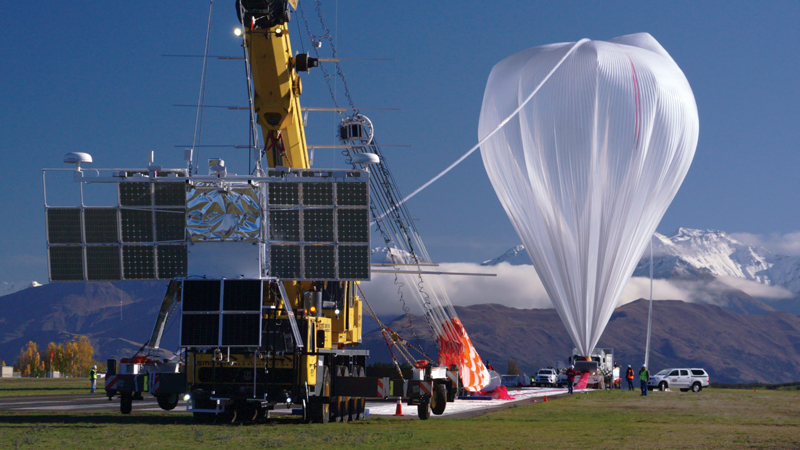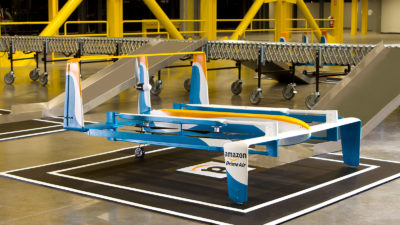Expanding reach, capabilities of balloon systems
By Debora Fairbrother, Christian Lockowandt, and Kurt Sehnert|December 2016
The Balloon Systems Technical Committee supports development and application of free-floating systems and technologies for buoyant flight in the stratosphere or atmospheres of other planets.
The mission capabilities of balloon systems have expanded significantly with the advent of new materials, computational skills and conceptual designs. Long-duration flight, altitude control and navigation have become major areas of focus across the field.
A 532,200-cubic-meter superpressure balloon launched in July in New Zealand carried the NASA-supported Compton Spectrometer and Imager gamma ray telescope for 46 days at approximately 110,000-feet altitude before being terminated on command in Peru. Another balloon, launched in January, was NASA’s latest launch of a long-duration balloon in Antarctica. In June, NASA re-established the Columbia Scientific Balloon Facility in Palestine, Texas, as a launch site with a balloon-borne imaging telescope mission. This campaign expands nighttime heavy-lift flight opportunities. Still another campaign, in Fort Sumner, New Mexico, combined science, technology and educational missions, including the High-Altitude Student Platform and X-Calibur, an instrument that utilizes the Wallops Arc-Second Pointing system to observe mass-accreting black holes and neutron stars.
Google’s Project Loon tested balloons at the McKinley Climatic Lab at Eglin Air Force Base, Florida, validating its design down to temperatures as low as minus 60 Celsius. One balloon flew for 190 days: It launched from Puerto Rico and went across Africa and over the Indian Ocean before being denied overflight permission in Indonesia; it then flew west to South America and landed within 20 kilometers of Winnemucca, Nevada. These long flights are providing valuable real-world data, testing navigational capabilities and allowing researchers to study the effects of ultraviolet light on the envelope materials.
South Dakota-based Raven Aerostar has initiated an internal program to develop a new generation of stratospheric balloons. To demonstrate directional control, three of these super-pressure balloons were launched from Bend, Oregon. After traveling over 1,800 kilometers with trajectories diverging by hundreds of kilometers, the balloons were maneuvered and terminated in March with the payloads all landing within a 4-km radius.
World View secured private financing for its new 12,500-square-meter global headquarters and stratospheric balloon manufacturing facility in Arizona, adjacent to Spaceport Tucson. Among other major projects, World View is developing Stratollite, a new altitude-controlled vehicle designed to provide persistent regional coverage for payloads up to 100 kilograms. World View announced a collaboration with Colorado-based Ball Aerospace to demonstrate the Stratollite platform for commercial remote-sensing applications and was awarded two new NASA Flight Opportunities Program contracts to conduct high-altitude balloon missions in 2016 and 2017.
In Europe, the Swedish Space Corp. launched the Polarized Gamma-ray Observer mission from Esrange Space Center near Kiruna, Sweden. This collaborative project between Swedish and Japanese scientific teams measured the polarization of soft gamma rays in the 25-80 kiloelectron-volt energy range. Using a modified design from 2013, the balloon flew a 2,000-kilogram gondola for approximately seven days at an altitude of 129,000 feet, landing in northern Canada. CNES, the French space agency, conducted its scientific zero-pressure balloon campaign and tested its new telemetry tracking and control system with two launches from the Swedish Space Corp. balloon facility at Esrange.
Smith College in Massachusetts conducted two campaigns utilizing its altitude-controlled meteorological balloons. With support from Finland’s Aboa station and the Meteorological Institute of Norway, one of the 300-gram balloons flew for 65 hours in Antarctica, performing repeated soundings from the ice surface to an altitude of 12,000 feet and navigating shallow atmospheric layers. A Department of Energy-funded project with SUNY Albany in New York and the Universidade Federal do Oeste do Para in Brazil supported nine balloon flights in the Amazon tracking river-induced circulations and measuring evolving atmospheric profiles over the undeveloped rainforest. ★
Contributors: Andre Vargas and Paul Voss


































